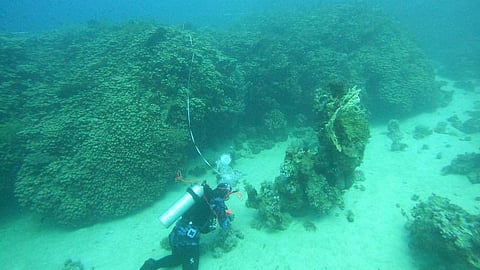Saudi Arabia discovers largest coral colony in Red Sea, rivaling global record
Colony could become a major attraction for tourists visiting AMAALA

Dubai: Red Sea Global (RSG) announced on Sunday the discovery of a massive coral colony off the northwestern coast of Saudi Arabia, within the waters of AMAALA.
The colony, a member of the Pavona species, rivals the size of the world record holder, a 32-by-34-meter coral structure documented in the Pacific, and is the largest of its kind ever recorded in the Red Sea.
AMAALA is a luxury tourism project being developed along the northwestern coast of Saudi Arabia, near the Red Sea.
According to a statement issued by RSG, the newly discovered colony could become a major attraction for tourists visiting AMAALA, offering a rare diving experience.
Visitor access will be permitted under strict guidelines aligned with RSG’s responsible tourism policies, designed to minimize ecological impact while showcasing the Red Sea’s unique underwater ecosystems.
Ahmed Alansari, Head of Environmental Protection and Regeneration at RSG, described the find as a testament to the ecological richness and resilience of the Red Sea.
“The discovery of a coral of such extraordinary dimensions demonstrates the ecological significance as well as the pristine beauty of the Red Sea,” he said.
“These giant corals are time capsules of information, critical for tracing past oceanographic changes and modeling responses to future environmental shifts. Understanding how this coral has survived for so long will be crucial for protecting reefs across the Red Sea, and potentially around the world, for generations to come.”
Determining the coral’s exact age poses challenges, given the invasive nature of standard dating techniques and the lack of published growth rates for this particular species in the Red Sea.
However, estimates based on the colony’s size, growth rates observed in the Pacific, and photogrammetry suggest that the coral is between 400 and 800 years old.
Exceptional resilience
Further studies led by researchers from RSG and King Abdullah University of Science and Technology (KAUST) are underway to better determine the coral’s age and understand the environmental conditions that have allowed it to thrive.
Red Sea corals are recognised globally for their exceptional resilience, having adapted genetically to warmer waters and higher salinity levels.
The colony was discovered by RSG scientists Rhonda Suka and Sylvia Jagerroos, who are now leading efforts to map and document the site.
“Finding such an invaluable specimen was truly a mind-boggling experience,” said Suka. “This colony’s resilience gives us hope for the continued survival of Red Sea corals in the face of rising environmental and human pressures.”
Jagerroos added, “A coral of this size is incredibly rare. Mapping these giants is crucial to conserving them, which is what the ‘Map the Giants’ project is working to achieve globally by documenting coral structures larger than five meters. This is the second giant colony RSG has submitted to the project in recent months.”
AMAALA, set to welcome its first guests later this year, aims to become the world’s most comprehensive health and wellness destination. The project will open with more than 1,400 hotel rooms across eight luxury resorts, offering a wide range of wellness programs led by internationally renowned operators.
Sign up for the Daily Briefing
Get the latest news and updates straight to your inbox



